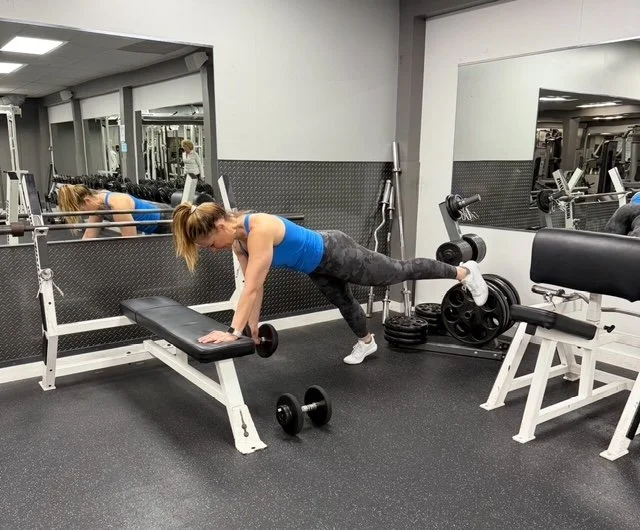My Last 5 Weeks of Body Recomposition and What Comes Next
Body recomposition, a method that combines fat loss and muscle building, is more than just a buzzword in the fitness world. It's a sustainable approach to achieving a leaner, stronger physique by focusing on simultaneous fat loss and muscle gain rather than just the number on the scale.
When I started my own body recomposition five weeks ago, I wasn’t sure what to expect. I've been driven by very specific goals, and because of that, I’ve had to adapt my strategies as I go. From stalled progress to breakthroughs, these five weeks have been a lesson in resilience, patience, and a deeper understanding of how my body responds to both nutrition and exercise.
Here’s a full breakdown of my experience, what I learned, and how I plan to reverse diet after hitting my next milestone.
The following content may contain affiliate links. When you click and shop the links, we receive a commission.
What Is Body Recomposition?
Before we get into the details, let's clarify what body recomposition actually means.
Body recomposition focuses on losing fat while simultaneously building or maintaining muscle mass. Unlike traditional “weight loss,” where success is measured purely by a smaller number on the scale, recomposition prioritizes body composition changes. This means you might weigh the same (or even more) while looking leaner, stronger, and healthier.
The key? Smart training and precise nutrition. It’s about fueling your body with the right macronutrients, creating a slight caloric deficit for fat loss, and ensuring proper stimulus through strength training to support muscle retention or growth.
Now, on to my personal goals and how I approached this life-changing method.
My Goals and Starting Point
When I started this body recomposition five weeks ago, my goal was clear—lose fat while eating as close to 2,000 or more calories per day and maintaining muscle mass. My biggest focus was sustainability. I wanted to avoid restrictive diets that force you into a "1200-calorie life," which often leads to burnout and metabolic adaptation.
My initial plan involved tracking my macros closely and incorporating resistance training to retain muscle. But like all journeys, there were twists and turns along the way.
Weekly Breakdown of Workouts
Strength training has been the backbone of my body recomposition plan. Here’s what my weekly workout structure looked like during the last five weeks:
Week 1-2
I started with 3-4 strength-training sessions per week, targeting specific muscle groups each day (e.g., push day, pull day, and lower body).
These early weeks were all about establishing a baseline and dialing in my consistency and to maintain my strength, especially in eating in deficit since muscle loss can happen.
My body, however, stayed the same, and I even noticed a slight weight gain, which was frustrating.
Week 3
By week three, I made my first major change. I noticed I had stalled. At first, I was eating too much protein, which made it hard to hit my carb and fat targets. Why does this matter? Carbs are crucial for energy during workouts, and improperly balanced macros meant my performance was sluggish.
I swapped my macros, slightly lowering protein and increasing carbs while keeping fat moderate.
The shift immediately boosted my energy levels and gym performance, and for the first time, I noticed consistent fat loss (around 1-3 pounds per week).
Week 4-5
To keep my body guessing (and prevent metabolic adaptation), I implemented macro cycling. This involved higher carb days around my more intense workout sessions and slightly lower ones on rest days. The goal here is not to dramatically cut calories but to optimize how my body uses fuel depending on training intensity.
The result? I was more energized and saw improvements in both strength and fat loss.
SHOP MY FAVORITE protein SNACKS
Diet and Nutrition Details
Nutrition has been a constant learning experience throughout this journey.
When progress stalled in the first few weeks, I realized that my caloric intake and macro distribution needed adjustment. While traditional weight loss strategies suggest slashing calories by large amounts, it’s not something I subscribe to. I chose a conservative calorie deficit and focused on other tools, such as macro adjustments and nutrient timing, to drive progress. My Top Protein Snacks can be found here and here.
One thing I’ve learned is that it’s not just about how much you eat, but what and when you eat that makes a difference. Small tweaks, like prioritizing protein intake and spreading meals evenly throughout the day, helped me feel more energized and stay on track without feeling deprived. If you’re curious about specific, actionable tips, I actually wrote a blog post about my top 8 nutrition tips that actually work! It’s filled with strategies that have helped me, and I think you might find them helpful too.
My Current Nutrition Strategies:
Macro Breakdown
Approximately 40% carbs, 30% protein, and 30% fat.
Swapping my macros to increase carbs around my workouts made a huge difference in energy and results.
No Drastic Deficits
I avoid dropping below 1900 calories to maintain energy and reduce the risk of muscle loss. I reduced calories gradually (around 100-150 calories when needed) instead of making big cuts.
Nutrient Timing
Timing carbohydrates around my workouts to fuel performance has been key to maintaining intensity during strength training.
Refeeds as Needed
On days when my body felt depleted, I implemented controlled refeeds (increasing carbs temporarily) to reset energy levels and boost hormonal balance.
My Reverse Diet Strategy
Body recomposition doesn’t end when you reach your fat loss goal. The key to long-term success lies in what comes next.
Once I lose another six pounds, I plan to transition into reverse dieting. For those unfamiliar, reverse dieting involves gradually increasing your caloric intake to maintenance levels after being in a caloric deficit.
The biggest myth about reverse dieting is that it makes you gain weight. Done correctly, it allows your metabolism to adjust back to higher calories without rapid fat gain.
My Reverse Diet Plan:
Gradual Calorie Increase
Once I hit my target, I’ll add 50-100 calories per week. This allows my body to adapt slowly and prevents fat gain.
Focus on Strength
I’ll keep strength training as the focus, using the additional calories to fuel heavier lifting sessions.
Listen to My Body
One of the most important aspects of reverse dieting is being mindful of how my body feels and responds, ensuring I maintain energy and balance.
SHARING SOME OF MY FAVORITE FAT LOSS MEALS
Body recomposition is not a quick fix; it requires patience, flexibility, and a willingness to adapt. The process goes beyond just numbers on the scale and encourages a mindset shift—which is why I’ll always advocate for sustainability and balance.
If you’re considering your own body recomposition, my biggest advice is to listen to your body. Experiment with macros, timing, and training plans until you find what works best for you.
And remember, fat loss does not mean starvation. You can achieve your goals without resorting to overly restrictive diets.
Curious about starting your own body recomposition? Reach out or comment below with your thoughts—I’d love to hear about your experiences or help answer any questions!
If you ready to take your diet to the next level? Download our Protein-Packed Recipe Guide to discover easy, delicious ways to enjoy more protein in your daily meals.
For personalized fitness advice and more routines, I recommend checking out Angie Bloom’s Personal Training Sessions. I have a lot of workouts on my blog, which you can find more, here.
Women’s March Madness Workout
Find my Women’s March Madness Workout, Here.
I love helping my clients let go of painful experiences to help them rebuild trust, self-confidence, self-worth and belief in themselves by addressing the root causes with subconscious change. The tool I use is called PSYCH-K®, and is a quick, pain-free and completely safe way to reprogram your subconscious and to create lasting change for once and for all.
Within my holistic practice, we help you create a lasting self-care practice to regulate your nervous system in your day to day-to-day life, so you can always hear and follow your whispers, instead of the big Mac truck.
If you’re ready to stop dimming your light, start making easy decisions with confidence, and follow through with what you want to achieve, while trusting your intuition, you can easily set up a free conversation with me.
>>>To Book Integrative Energetic Healing Services, click here
You might also like:
My 7 Day Clean Eating Guide Eating 100g of Protein (No bars or protein powder)
How to Heal and Help Your Anxiety with Six Tools to Use Daily
Spring Cleaning Made Easy: How to Get Your House Fresh and Clean in Just One Day
Here’s a great total body workout that you can do from home. As a personal trainer for over 20 years, the most important piece when it comes to your health is making sure you are CONSISTENT. If you aren’t consistent, then you will never see results.
I love seeing you all tag me on Instagram! It’s so fun when you complete a workout and show me your progress. Allow me to cheer you on! Tag me if you try this workout @__angiebloom__
One More Post I Think You’ll Love >>>
A Favorite Post: Try my Favorite Healthy Cookie Dough




















































